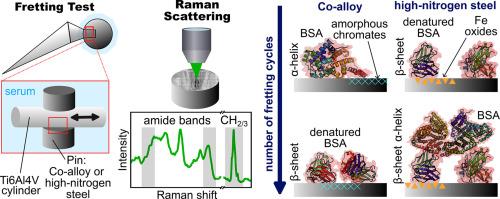Protein-metal interactions due to fretting corrosion at the taper junction of hip implants: An in vitro investigation using Raman spectroscopy
IF 9.4
1区 医学
Q1 ENGINEERING, BIOMEDICAL
引用次数: 0
Abstract
Modular hip implants are a clinically successful and widely used treatment for patients with arthritis. Despite ongoing retrieval studies the understanding of the fundamental physico-chemical mechanisms of friction and wear within the head-taper interface is still limited. Here, we Raman-spectroscopically analyze structural features of the biotribological material which is formed within the taper joint between Ti6Al4V and low-carbon cobalt alloy or high-nitrogen steel surfaces in in vitro gross-slip fretting corrosion tests with bovine calf serum. As a function of the fretting duration, we investigate short and long aliphatic chains and their adsorption behavior on the cobalt- and steel-type surfaces. Using the intensity and frequency shifts of the amide I and III Raman bands, we furthermore identify progressive protein folding and unfolding including the secondary structures of -helix, -sheet, and random-coil configuration as well as the formation of proteinaceous clusters depending on the hydrophilicity of the metallic surfaces. We additionally find a mixture of chromates and iron oxides with tryptophan and tyrosine at the worn cobalt alloy and high-nitrogen steel surfaces, respectively. Also, for long fretting duration, sp hybridized amorphous carbon is formed due to fretting-induced cleavage of proteins.
Statement of significance
Despite efforts enhancing the biomedical tribology of hip implants, the impact of the organic environment on friction and wear at the femoral head-stem taper interface is limitedly understood. Using Raman spectroscopy we resolve structural changes within the biotribological material agglomerated at biomedical-grade metal alloys due to metal-organic interactions during in vitro fretting corrosion tests. Adsorption of short and long aliphatic chains, progressive protein (un)folding and proteinaceous cluster formation depend to a distinguishable extent on the fretting duration and type of alloy. Chromates and iron oxides are mixed with tryptophan and tyrosine, and amorphous carbon is formed resulting from a fretting-induced cleavage of serum proteins. Such information spectroscopically gleaned from biotribological material are vital to improve the design and performance of taper junctions.

髋关节植入物锥体交界处的摩擦腐蚀导致的蛋白质-金属相互作用:利用拉曼光谱进行的体外研究。
模块化髋关节植入物是治疗关节炎患者的一种临床成功且应用广泛的方法。尽管目前正在进行回收研究,但人们对髋关节头锥形界面内摩擦和磨损的基本物理化学机制的了解仍然有限。在此,我们通过拉曼光谱分析了 Ti6Al4V 与低碳钴合金或高氮钢表面在体外与牛小牛血清粗滑摩擦腐蚀试验中锥度接合处形成的生物ribological 材料的结构特征。我们研究了短脂肪链和长脂肪链在钴和钢表面上的吸附行为,并将其作为摩擦持续时间的函数。利用酰胺 I 和 III 拉曼带的强度和频移,我们进一步确定了蛋白质的渐进折叠和展开,包括 α-螺旋、β-薄片和无规线圈构型的二级结构,以及蛋白质簇的形成,这取决于金属表面的亲水性。此外,我们还在磨损的钴合金和高氮钢表面发现了铬酸盐和铁氧化物的混合物,其中分别含有色氨酸和酪氨酸。此外,在长时间的摩擦过程中,由于摩擦引起的蛋白质裂解,会形成 sp2 杂化的无定形碳。意义说明:尽管人们努力提高髋关节植入物的生物医学摩擦学,但对有机环境对股骨头-股骨柄锥体界面摩擦和磨损的影响了解有限。我们利用拉曼光谱分析了体外烧蚀试验中有机金属相互作用导致生物医学级金属合金上聚集的生物ribological材料的结构变化。长短脂肪族链的吸附、蛋白质的逐渐(非)折叠和蛋白质团的形成在很大程度上取决于烧蚀持续时间和合金类型。铬酸盐和铁氧化物与色氨酸和酪氨酸混合,无定形碳的形成是由于烧蚀引起的血清蛋白裂解。从生物ribological 材料中收集到的这些光谱信息对于改进锥形连接的设计和性能至关重要。
本文章由计算机程序翻译,如有差异,请以英文原文为准。
求助全文
约1分钟内获得全文
求助全文
来源期刊

Acta Biomaterialia
工程技术-材料科学:生物材料
CiteScore
16.80
自引率
3.10%
发文量
776
审稿时长
30 days
期刊介绍:
Acta Biomaterialia is a monthly peer-reviewed scientific journal published by Elsevier. The journal was established in January 2005. The editor-in-chief is W.R. Wagner (University of Pittsburgh). The journal covers research in biomaterials science, including the interrelationship of biomaterial structure and function from macroscale to nanoscale. Topical coverage includes biomedical and biocompatible materials.
 求助内容:
求助内容: 应助结果提醒方式:
应助结果提醒方式:


